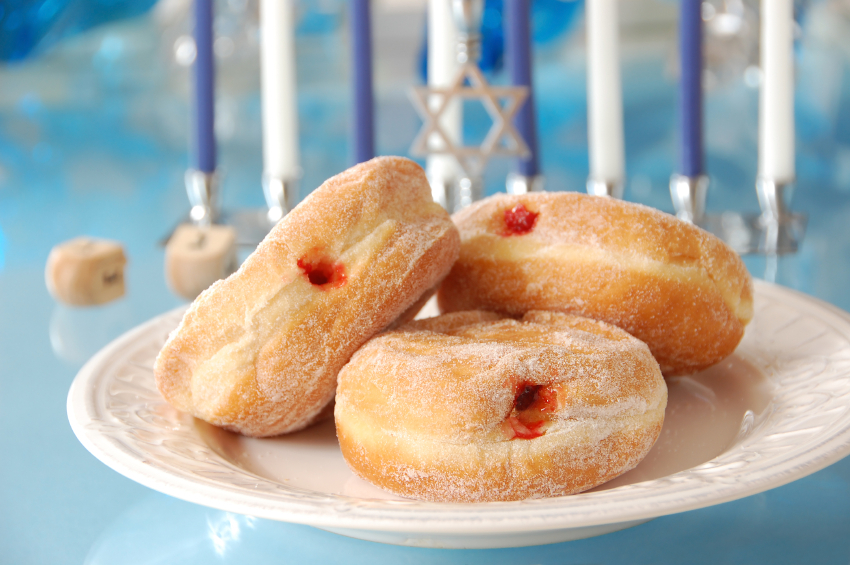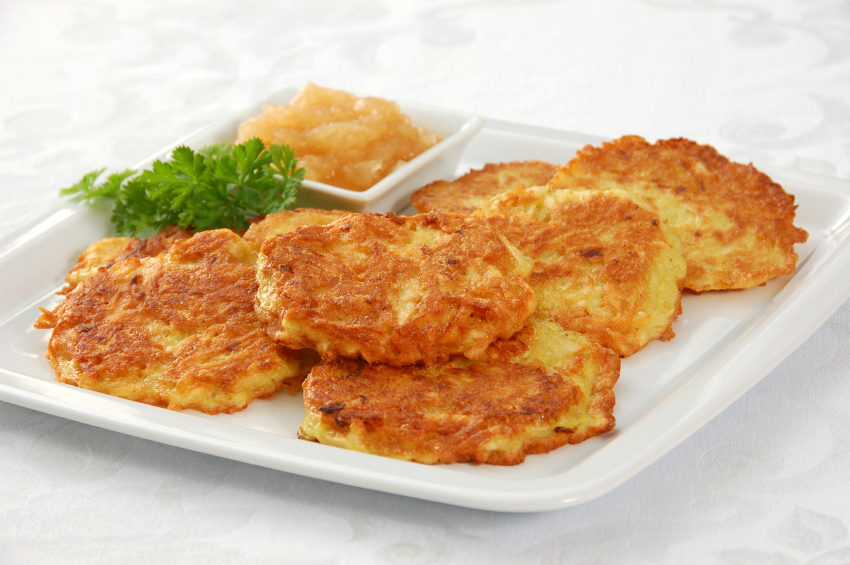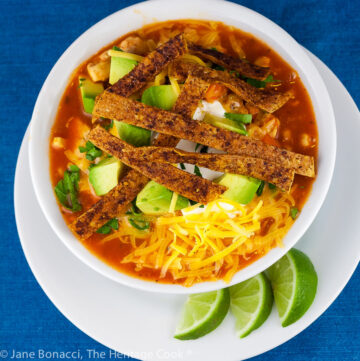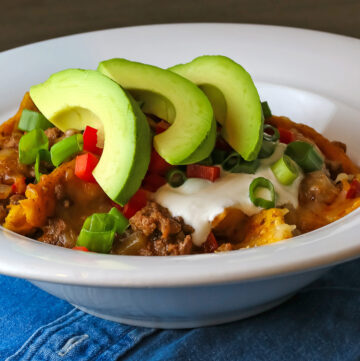
The Jewish delicacy Sufganiyot, jelly-filled doughnuts!
Today is the beginning of Hanukkah, the Jewish Festival of Lights, a celebration of a miracle that happened over 2000 years ago in Jerusalem. After the ruling King outlawed traditional religious practices, there was a revolt in which a small army of Jewish people defeated a much larger armed force. The victors returned to their Temple only to find it desecrated.
They cleaned up the Temple and to celebrate their renewed ability to publicly practice their religion they lit the holy fire in the Temple menorah (the many-branched candelabra symbol of Judaism). They searched through the debris but were only able to find enough oil for one day. Miraculously the oil lasted for a full eight days, creating the basis for today’s modern eight-day celebration.
These days Hanukkah is celebrated by lighting one candle each night until all eight are lit, singing blessings, eating foods fried in oil, giving “gelt” or money to children and spinning the dreidel. In addition to the beliefs that I grew up with, I love exploring and learning about the other beautiful stories and histories that my friends celebrate.

Traditional Potato Latkes with Applesauce
A few weeks ago I polled some of my wonderful Jewish friends, asking them what foods they prepare each year for Hanukkah. The list was a varied as their backgrounds, but there were some universal favorites. Potato Latkes with applesauce and sour cream are by far the most popular, followed closely by beef brisket, Kugel and apple fritters. No matter what you decide to serve, traditions will be upheld and new ones created each year.
I pulled together a collection of ten recipes from a variety of sources, giving you what I consider a penultimate Hanukkah feast. I can tell you that if I were invited to a party where these were served, I would consider myself incredibly lucky … and very full, LOL!
Today’s Recipes: Butter Lettuce and Radish Salad with Lemon-Garlic Vinaigrette, Caramelized Broccoli with Garlic, Holiday Beef Brisket with Onions, Ina’s Rugelach, Michael Symon’s Potato Latkes with Apples, Oven-Roasted Beets, Potato Kibbeh, Savory Noodle Kugel, Sufganiyot, and Walnut-Pomegranate Chicken.
Starting off with the quintessential Hanukkah food, potato latkes as appetizers. You can serve them very traditionally with dollops of applesauce and sour cream, or you can follow Chef Symon’s suggestion and grate some apples and cook them into the latkes themselves.
Next we have a light and flavorful salad made with tender butter lettuce and snappy radishes. Then you have a choice (or if you are having a huge party, serve both) of making brisket with onions or walnut-pomegranate glazed chicken for the main course. I would love to have either!

Fresh Butter Lettuce
Some side dishes that will bring back memories are a savory noodle Kugel, oven-roasted beets, caramelized broccoli with garlic and a beautiful combination of Algerian and Assyrian flavors in the potato kibbeh, meat-filled potato pancakes.
And of course we can’t miss the desserts. I would probably serve the Sufganiyot (jelly-filled doughnuts) with coffee or tea at the end of the meal and then send my guests home with some homemade rugelach to snack on the next day.

Potato Kibbeh – meat-filled potato pancakes
If you want to learn more about Jewish food, here is a list of some of our best chefs and cookbook authors:
Even if you are not Jewish, I urge you to explore some of these wonderful recipes and broaden your culinary horizons. The holidays are a beautiful time of peace and love and the perfect time to help teach children about acceptance and harmony.
I wish you all a beautiful, delicious and peaceful Hanukkah season!
Jane’s Tips and Hints:
If you want, you can use a food processor to shred the potatoes for the latkes. They turn out lighter and crunchier!
Kitchen Skill: Non-Greasy Frying
Many people avoid frying foods because they think everything will come out greasy and heavy. The biggest issue is the heat of the oil. If it is not hot enough, the foods will absorb the oil and be less palatable. But if the oil is at the right temperature, it will seal the exterior of the foods, sealing in the flavors and keeping the oil from penetrating. Always use a thermometer to help you regulate the heat levels and keep the oil at the correct temperature. Even properly fried foods will have an excess of fat on the outside, so always drain them on paper towels. Your foods will be perfectly cooked, nicely crispy and not at all greasy!


- 4 medium baking (Russet) potatoes (about 2 lb)
- 1 egg beaten
- 1/4 tsp baking powder
- 1 tsp flour
- 1 tsp salt
- 1/4 tsp freshly ground black pepper
- 1 medium yellow onion
- 1/2 stick (4 oz) butter or olive oil
- Peel the potatoes and keep them submerged in a bowl of cold water.
- In a mixing bowl, combine the egg, baking powder, flour, salt and pepper.
- Using the large holes on a box grater, grate the onion and add it to the egg mixture. Grate the potatoes onto a clean kitchen towel and wring as much water out of them as you can, then add them to the egg mixture. Toss so that the potato, onion and egg mixture are evenly combined.
- Heat a medium sauté pan over medium heat and melt half the butter (or use two smaller pans if you want to cook them all at the same time).
- Shape four pancakes, each about 4 inches in diameter and about a half-inch thick. Sauté them in the butter until each side is golden brown, about 3 minutes per side or so. Transfer the pancakes to a sheet pan lined with a double thickness of paper towels and keep in a warm (180°F to 200°F) oven while you repeat the process, making four more pancakes.
- To make smaller pancakes, lift a small pile of the potato mixture on a fork and transfer to the hot butter or oil. Pat flat with the fork and cook until golden brown then carefully flip with a spatula and cook the second side until done.
- Serve immediately with a little sour cream or sautéed apples.
- If you want you can also grate some apples and include them with the potatoes for the flavor of applesauce without making the sauce.
- Yield: 8 appetizer servings


- Vinaigrette
- 2 tbsp fresh lemon juice
- 1/2 tsp sherry vinegar
- 1/2 tsp sugar
- 1 clove garlic, smashed and peeled
- 1 tsp finely grated lemon zest
- 1/4 tsp kosher salt
- 1/4 cup canola oil
- Table salt and freshly ground black pepper to taste
- Salad
- 3 heads butter lettuce, outer leaves discarded, leaves torn
- 12 radishes, trimmed and thinly sliced
- 1/4 cup mixed fresh herbs, such as parsley, tarragon, chervil, basil, and chives, minced
- 1 (3-oz) piece Parmesan cheese
- In 1-cup liquid measuring cup, whisk together lemon juice, vinegar, sugar, and 2 tbsp water. Using mortar and pestle or food processor, grind or crush garlic, lemon zest, and kosher salt into fine paste. Whisk paste into lemon juice mixture. Gradually whisk in oil. Whisk in table salt and pepper to taste.
- In large bowl, toss together lettuce, radishes, minced herbs, and dressing. Divide mixture among 6 salad plates. Using vegetable peeler, shave curls of Parmesan atop each salad and serve.
- Kosher salt
- Freshly ground pepper
- 2 tsp chopped thyme
- 1 tsp chopped oregano
- 1 tbsp sweet Hungarian paprika
- 1 (6 lb) flat-cut brisket
- 1/2 cup dried porcini mushrooms (1/2 oz)
- 1 cup hot water
- 3 tbsp pure olive oil
- 2 cups dry vermouth or white wine
- 1 cup chicken stock or canned low-sodium broth
- 2 cups chopped canned Italian tomatoes
- 3 bay leaves
- 4 medium onions, thinly sliced
- 3 tbsp chopped garlic
- In a small bowl, combine 2 tsp of salt and 1 tsp of pepper with the thyme, oregano and paprika. Rub the seasonings all over the brisket.
- In a medium heatproof bowl, cover the porcini with the hot water and set aside until softened, about 20 minutes. Remove the mushrooms from the soaking liquid; rinse and coarsely chop them. Reserve the soaking liquid.
- Preheat the oven to 350°F.
- Heat the oil in a large enameled cast-iron casserole until shimmering. Add the brisket, fat side down, and cook over moderately high heat until well-browned, about 8 minutes per side. Transfer the brisket to a platter and pour off any excess fat from the casserole. Add the vermouth and chicken stock, then pour in the reserved mushroom soaking liquid, stopping before you reach the grit at the bottom. Scrape up the browned bits from the bottom of the casserole and stir in the tomatoes, porcini and bay leaves.
- Return the brisket to the casserole, fat side up. Scatter the onions and garlic over the meat and into the liquid and bring to a boil. Cover and cook in the oven for 1 hour. Uncover and cook for 30 minutes. Spoon the onions on top of the brisket and cook for about 30 minutes longer to brown the onions. Push some of the onions back into the liquid, cover and braise for about 2 hours, or until the meat is fork-tender.
- Transfer the brisket to a carving board and cover loosely with foil. Simmer the sauce for a few minutes, until it is deeply flavored, then season with salt and pepper. Discard the bay leaves. Carve the brisket across the grain into 3/8-inch thick slices and arrange on a large, warmed platter. Spoon the sauce and onions over the meat and serve.
- Make Ahead: The seasoned brisket can be refrigerated overnight before cooking. If cooking the brisket ahead, let the meat cool in the sauce before refrigerating. Skim the fat from the surface and slice the brisket, then rewarm the meat in the sauce.
- 1 (3-1/2 lb) chicken, cut up
- 2 tbsp vegetable oil
- 1 medium onion, chopped
- 2 cups walnuts, ground
- 1/3 cup water
- 2 tbsp lemon juice
- 2 cups pomegranate juice or 1/2 cup pomegranate molasses
- 1 tbsp tomato paste
- Salt and freshly ground black pepper
- 2 tbsp sugar
- Brown the chicken in a large skillet in the hot oil and remove to drain on a paper towel.
- Brown the chopped onion in the same oil.
- In another pan, brown the walnuts over medium-low heat, stirring constantly, without using any additional oil.When brown, add the onion. Then slowly add the hot water so that the mixture does not stick. It should not be too liquid - more like a paste. Then add the lemon juice, pomegranate juice, tomato paste, salt and pepper to taste, and sugar, stirring with a spoon. When well mixed, add the chicken.
- Bring the mixture just to the point of a low boil. Decrease to a simmer and let cook, covered, until the chicken is very tender, about 45 minutes. If the sauce is not thick enough, remove the chicken and boil the liquid down until the desired thickness is reached, stirring as it cooks.
- When ready to serve, place the chicken on a dish, pour the sauce over and serve with rice.
- Yield: 4 to 6 servings
- 8 oz noodles
- 4 to 5 tbsp vegetable oil
- 2 large onions, chopped
- Salt & freshly ground black pepper, to taste
- 1/2 to 1 tsp paprika, depending on taste, plus
- Extra paprika, for sprinkling
- 2 large eggs, beaten well
- Preheat oven to 350°F.
- Cook noodles uncovered in a large pot of boiling salted water over high heat about 4 minutes or until nearly tender but firmer than usual. Drain, rinse with cold water, then drain well again. Transfer to a large bowl.
- Heat 3 to 4 tbsp oil in large skillet over medium-low heat. Add onions and saute about 20 minutes or until very tender and light brown, (but not burned!) stirring occasionally. Add salt, pepper, and 1 tsp paprika, and saute about 5 minutes or until well browned.
- Cool slightly. Stir onion mixture into noodles. Adjust seasoning, mixture should be seasoned generously. Add eggs and mix well.
- Oil a 2 quart baking dish and add noodle mixture. Sprinkle with remaining tbsp oil, then dust with paprika.
- Bake uncovered 1 hour or until set. Serve from baking dish.
- Yield: 6 to 8 servings


- 3-1/2lb assorted medium-sized fresh beets, greens trimmed and washed
- 1/4cup olive oil
- 1tsp coarse sea salt, such as Maldon
- 1/2tsp freshly ground pepper
- 1tbsp fresh lemon juice
- Heat the oven to 400°F. Coat the beets with 2 tbsp of the olive oil and wrap with foil.
- Place beets in a medium roasting pan and bake until tender when pierced with a fork – about 45 minutes.
- Unwrap the beets and let cool for 10 minutes. Slip off the skins with a paring knife.
- Cut them into quarters and toss with the remaining olive oil, salt, pepper and lemon juice.
- Serve warm or room temperature.
- Yield: about 6 servings
- 3 tbsp extra-virgin olive oil, divided
- 2 heads of broccoli (1-1/4 lb total), stems peeled and heads halved lengthwise
- 1/2 cup water
- 3 garlic cloves, thinly sliced
- Pinch of crushed red pepper
- Salt and freshly ground black pepper
- 2 tbsp fresh lemon juice
- In a large, deep skillet, heat 2 tbsp of the olive oil. Add the broccoli, cut side down, cover and cook over moderate heat until richly browned on the bottom, about 8 minutes. Add the water, cover and cook until the broccoli is just tender and the water has evaporated, about 7 minutes.
- Add the remaining 1 tbsp of olive oil along with the garlic and the crushed red pepper and cook uncovered until the garlic is golden brown, about 3 minutes. Season the broccoli with salt and black pepper, drizzle with the lemon juice and serve.


- Potato Mixture
- 1kg (2 lb) white potatoes, peeled and cut into quarters
- 2 eggs
- 1 medium onion, minced
- 2 cloves garlic, crushed
- 1/2 tsp salt
- 1/4 tsp turmeric
- 1/4 tsp cinnamon
- 1/4 cup parsley, finely chopped
- Meat Filling
- 1/4 kg (1/2 lb) lean ground beef
- 1 small onion, minced
- 1 clove garlic, crushed
- 1/4 cup parsley
- 1/4 cup pine nuts, toasted
- 1 tsp allspice
- 1/4 tsp freshly ground pepper
- 1/4 tsp cinnamon
- 1/4 tsp nutmeg
- 1/4 tsp cardamom
- Pinch of ground cloves
- Pinch of ground ginger
- 1/4 tsp salt
- 1 cup canola oil or oil of your choice
- Flour for dredging
- Cook potatoes in water, until tender. Drain the potatoes and mash them until smooth. Add eggs, onion, garlic, salt, turmeric, cinnamon and parsley.
- In a frying pan, saute the onion and garlic in a little olive oil. Add the ground beef, parsley, pine nuts, and all of the spices. Cook until the meat is cooked through. Set aside to cool.
- Moisten your hands with water, and take a couple of tbsp of the potato mixture, flatten it in the palm of your hand. Place 1 tbsp of the meat mixture in the middle. Carefully bring the sides of the potato over the meat mixture. You may have to add a little more of the potato mixture to the top of the patty. Close the patty and flatten it.
- Moisten your hands in cold water before you make each patty. Place the patties on a tray and refrigerate for 30 minutes. Dredge the patties lightly in flour before frying.
- Yield: 4 to 6 as a main course


- 8 oz cream cheese, at room temperature
- 1/2 lb unsalted butter, at room temperature
- 1/4 cup granulated sugar plus 9 tbsp
- 1/4 tsp kosher salt
- 1 tsp pure vanilla extract
- 2 cups all-purpose flour
- 1/4 cup light brown sugar, packed
- 1-1/2 tsp ground cinnamon
- 3/4 cup raisins
- 1 cup walnuts, finely chopped
- 1/2 cup apricot preserves, pureed in a food processor
- 1 egg beaten with 1 tbsp milk, for egg wash
- Cream the cheese and butter in the bowl of an electric mixer fitted with the paddle attachment until light. Add 1/4 cup granulated sugar, the salt, and vanilla. With the mixer on low speed, add the flour and mix until just combined. Dump the dough out onto a well-floured board and roll it into a ball. Cut the ball in quarters, wrap each piece in plastic, and refrigerate for 1 hour.
- To make the filling, combine 6 tbsp of granulated sugar, the brown sugar, 1/2 tsp cinnamon, the raisins, and walnuts.
- On a well-floured board, roll each ball of dough into a 9-inch circle. Spread the dough with 2 tbsp apricot preserves and sprinkle with 1/2 cup of the filling. Press the filling lightly into the dough. Cut the circle into 12 equal wedges—cutting the whole circle in quarters, then each quarter into thirds. Starting with the wide edge, roll up each wedge. Place the cookies, points tucked under, on a baking sheet lined with parchment paper.
- Chill for 30 minutes.
- Preheat the oven to 350°F.
- Brush each cookie with the egg wash. Combine 3 tbsp granulated sugar and 1 tsp cinnamon and sprinkle on the cookies. Bake for 15 to 20 minutes, until lightly browned. Remove to a wire rack and let cool.
- Yield: 4 dozen cookies


- 1 scant tbsp (1 package) dry yeast
- 4 tbsp sugar
- 3/4 cup lukewarm milk or warm water (*use butter and milk if serving at a milk meal, and water and pareve margarine for a meat meal)
- 2-1/2 cups all-purpose flour
- Pinch of salt
- 1 tsp ground cinnamon
- 2 eggs, separated
- 2 tbsp (1/4 stick) butter or pareve margarine, softened*
- Apricot or strawberry preserves
- Sugar
- Vegetable oil for deep-frying
- Mix together the yeast, 2 tbsp of the sugar, and the milk. Let sit to make sure it bubbles.
- Sift the flour and mix it with the remaining sugar, salt, cinnamon, egg yolks, and the yeast mixture.
- Knead the dough until it forms a ball. Add the butter or margarine. Knead some more, until the butter is well absorbed. Cover with a towel and let rise overnight in the refrigerator.
- Roll out the dough to a thickness of 1/8 inch.
- Cut out the dough into 24 rounds with a juice glass, or any object about 2 inches in diameter. Take 1/2 tsp of preserves and place in center of 12 rounds. Top with the other 12. Press down at edges, sealing with egg whites. Crimping with the thumb and second finger is best. Let rise for about 30 minutes.
- Heat 2 inches of oil to about 375°F. Drop the doughnuts into the hot oil, about 5 at a time. Turn to brown on both sides. Drain on paper towels.
- Roll the doughnuts in sugar.
- Yield: about 12 pieces
Thank You!








Angel Collins
Those are really scrumptious dishes. The first one is just like Dunkin Donuts I guess. I want to try them out. 🙂 Thanks for sharing. 🙂
Rease
I love latkes! I will have to try this recipe, I can never make them as good as they are in restaurants.
Jersey Girl Cooks
Great menu. Everything looks delicious.
Jersey Girl Cooks
Great menu! Everything looks delicious!